Data Center Construction Financial Model
Data Center Construction Financial Models in Excel provide a structured framework to analyze the financial health and project profitability throughout the construction phases. You get 2 very detailed Excel Workbooks.
Financial Model For Data Center Construction
This financial model for a data center construction project involves projecting the financial performance of the project over a specific period of 24 months. The model includes three core financial statements: the Income Statement, Cash Flow Statement, and Balance Sheet. Below is a detailed description of each component, including revenues and expenses specific to data center construction.
How can this model help you?
Forecasting and Predictive Analysis
Use historical data and market trends to:
- Predict future cost overruns and revenue fluctuations.
- Forecast cash flow requirements to avoid liquidity issues.
- Estimate project completion time and financial impact of delays.
Example: Forecasting models can analyze past information from similar data center construction projects to predict cost escalations in materials like HVAC units, UPS systems, and network cabling.
Budgeting and Cost Optimization
Analyze multiple cost components (labor, leasing, utilities, equipment) and view ways to:
- Minimize expenses by identifying more cost-efficient suppliers.
- Optimize labor costs by recommending automation or workforce adjustments.
- Detect unnecessary spending and suggest budget reallocations.
Risk Assessment and Fraud Detection
Help you:
- Identify high-risk areas in financial planning (e.g., delays in payments or supply chain issues).
- Detect fraudulent transactions by analyzing spending patterns.
- Evaluate insurance claims risks to optimize insurance coverage.
Financial Reporting & Insights
Helps you automate financial reports and provide real-time dashboards that show:
- Revenue breakdown (Building Construction, HVAC, PDUs, etc.).
- Expense tracking (salaries, leasing, utilities).
- Profitability metrics and anomaly detection.
Cash Flow Management
- Predict cash shortfalls and suggest loan or credit solutions.
- View accounts payable and receivable tracking.
- Help optimize working capital by recommending when to pay vendors or collect payments.
Data Center Construction Timeline and Costing Streams For Civil Works
The detailed project timeline and cost sources for a data center construction project can be categorized based on various construction services and installations. These might include:
Lay Access Routes
Prepare and construct temporary or permanent access roads to enable movement of materials and personnel across the site.Roads and Drainage
Build internal roads and implement drainage systems to manage water flow and prevent site flooding.Fences and Gates
Install perimeter fencing and secure access points to ensure site security and controlled entry.Dig Trenches for Cables
Excavate trenches for the underground placement of electrical and communication cables.Install Electrical Switchgear
Set up the switchgear system to control and distribute electrical power safely across the facility.Office and HR Welfare
Establish site offices and provide welfare facilities (toilets, break rooms, etc.) for staff and contractors.Panel Frame Installation
Assemble and install structural frames that will support solar panels.Building Infrastructure Cabling
Lay and connect electrical cabling required for operational infrastructure and system integration.Panel Assembly
Assemble the solar panel units, ensuring all components are correctly fitted and secured.Solar PV Module Mounting
Mount the solar photovoltaic modules onto the pre-installed frames and connect them to the electrical system.

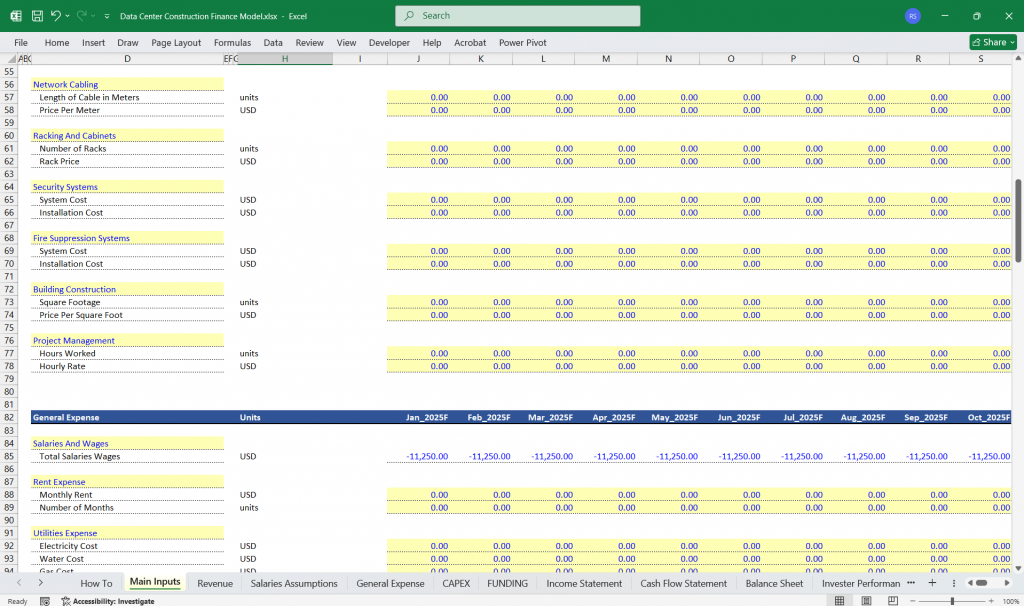
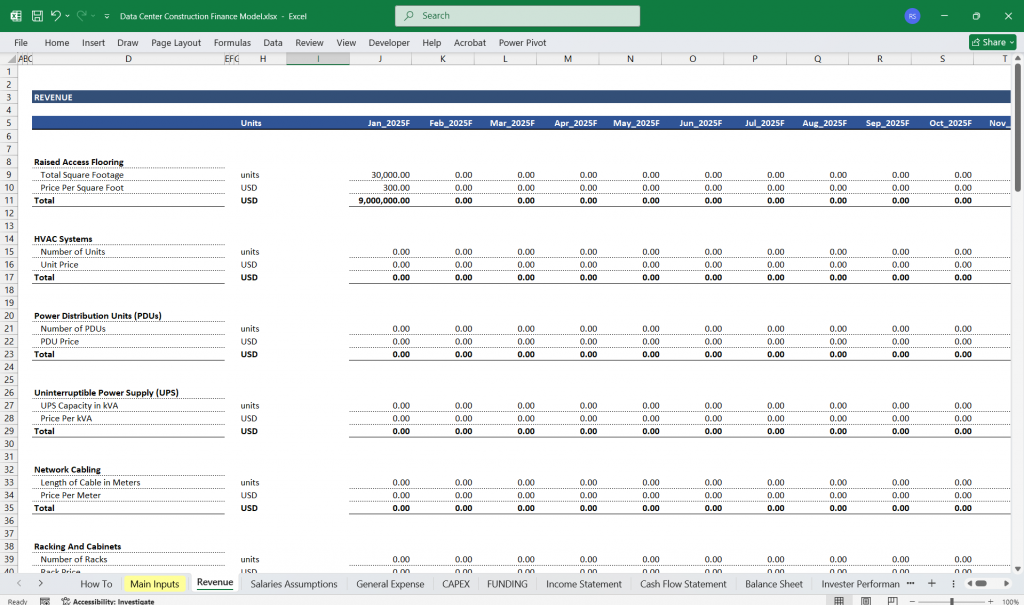
Data Center Construction Financial Model Income Statement
The Income Statement (or Profit and Loss Statement) summarizes revenues, costs, and expenses over a period to determine profitability.
Data Center Construction Timeline And Costing Streams For Electrical Works
Revenues are generated from the construction and installation of various components of the data center. These include:
HVAC Systems
Heating, Ventilation, and Air Conditioning systems to regulate temperature and airflow, critical for equipment cooling and human comfort.- Equipment Costs
Installation Costs
Commissioning Costs Power Distribution Units (PDUs)
Devices that distribute electrical power to various components in data centers or facilities, ensuring reliable power delivery.- Generator Costs
UPS Costs
PDU Costs
Wiring Costs Uninterruptible Power Supply (UPS)
Backup power systems that provide temporary electricity during outages, protecting critical equipment from power loss.Network Cabling
Installation of physical cables (fiber optic, Ethernet, etc.) to establish data and communication networks.- Switch Costs
Router Costs
Cabling Costs
Rack Costs Fire Suppression Systems
Safety systems designed to detect and suppress fires, often using gas, mist, or chemical agents to protect sensitive equipment.IT Installation
Setup and configuration of servers, storage units, and other information technology infrastructure components.Switchgear and Protection
Electrical equipment used to isolate and protect power systems during faults or maintenance, ensuring safety and system reliability.Reactive Equipment
Devices like capacitors or reactors used to manage power factor and voltage stability in electrical systems.Security Equipment
Installation of surveillance cameras, access control systems, and alarms to monitor and secure the facility.Safety and Array Testing
Final verification processes to ensure all systems are safely installed and solar arrays or electrical systems are functioning correctly.
Operating Expenses (OPEX)
Staffing Costs: Salaries for IT staff, security personnel, and management.
Facility Maintenance: Costs for maintaining the physical infrastructure (e.g., generators, UPS systems).
Sales and Marketing: Expenses for acquiring new clients and promoting services.
General and Administrative (G&A): Office expenses, insurance, legal fees, and other overheads.
Depreciation and Amortization
Depreciation of physical assets like specialist installation equipment, cooling systems, and construction plant.
Amortization of intangible assets like software licenses.
EBITDA and Net Profit
EBITDA (Earnings Before Interest, Taxes, Depreciation, and Amortization): A measure of operating profitability.
Net Profit: Revenue minus all expenses, including taxes and interest.
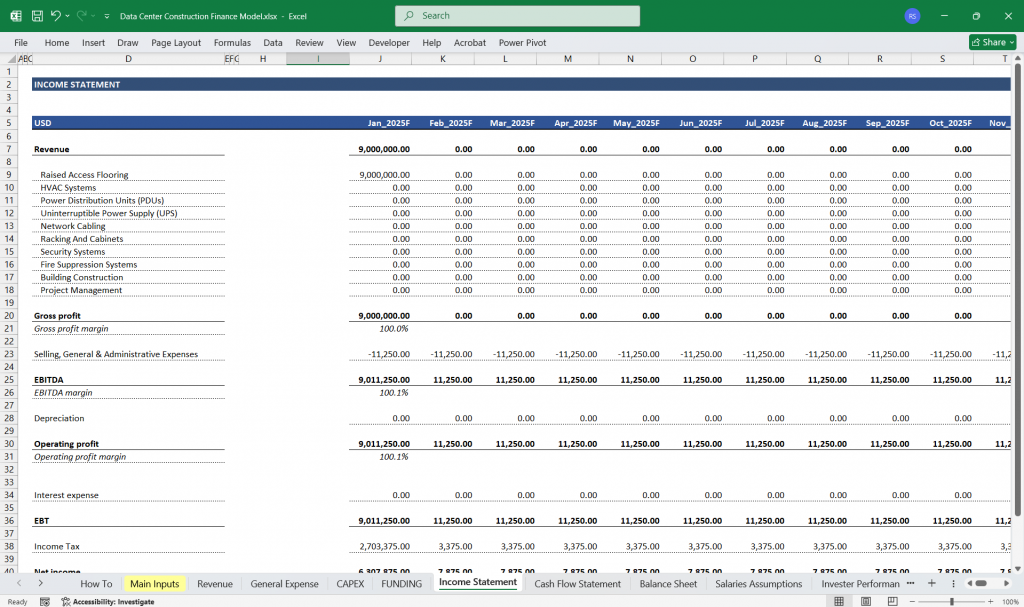
Data Center Construction Financial Model Cash Flow Statement
The Cash Flow Statement tracks the inflows and outflows of cash, divided into three sections: Operating Activities, Investing Activities, and Financing Activities.
Operating Activities
Cash Inflows:
Revenue from colocation, cloud services, and other offerings.
Receipts from clients for services rendered.
Cash Outflows:
Payments for power, cooling, and bandwidth.
Salaries and wages.
Payments to vendors for hardware and software.
Investing Activities
Capital Expenditures (CapEx):
Purchase of servers, storage, and networking equipment.
Construction or expansion of data center facilities.
Upgrades to cooling systems and power infrastructure.
Other Investments:
Investments in software or technology platforms.
Financing Activities
Debt Financing:
Proceeds from loans or bonds issued to fund CapEx.
Repayment of principal and interest on debt.
Equity Financing:
Issuance of shares to raise capital.
Dividend payments to shareholders.
Net Change in Cash
The sum of cash flows from operating, investing, and financing activities.
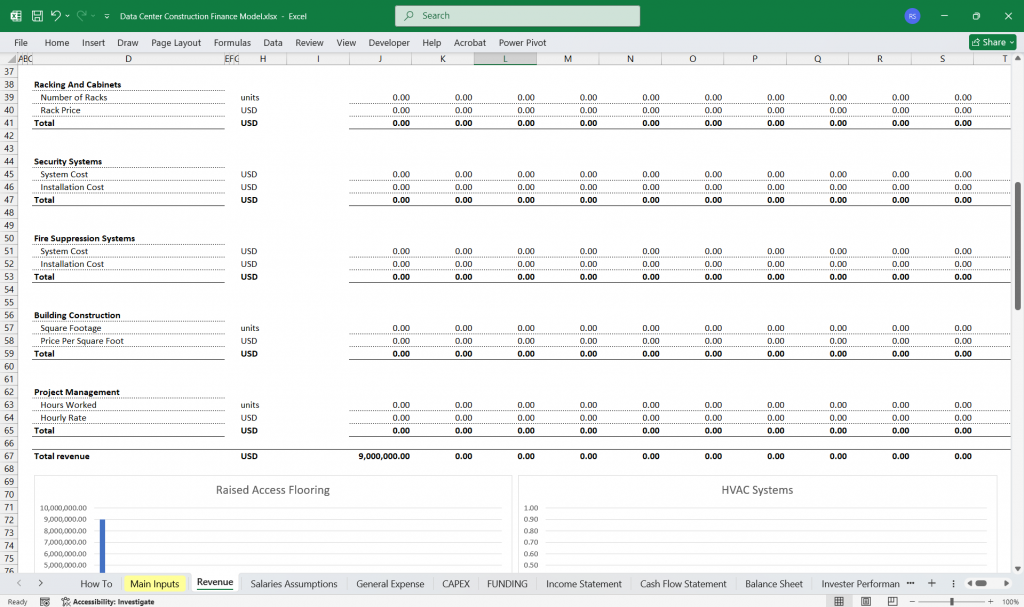

Data Center Construction Financial Model Balance Sheet
The Balance Sheet provides a snapshot of the company’s financial position at a specific point in time, showing assets, liabilities, and equity.
Assets
Current Assets:
Cash and cash equivalents.
Accounts receivable (unpaid invoices from clients).
Inventory of the required materials and equipment for the data center construction.
Non-Current Assets:
Property, plant, and equipment (PP&E): Land, buildings, HVAC systems, PDUs, UPS systems, data center network cabling, racks, and security systems.
Accumulated depreciation (reduction in value of PP&E over time).
Liabilities
Current Liabilities:
Accounts payable (unpaid bills to suppliers).
Short-term debt (loans due within a year).
Accrued expenses (unpaid wages, utilities, etc.).
Non-Current Liabilities:
Long-term debt (loans due after a year).
Equity
Shareholder equity, including retained earnings and capital contributions.
Balance Sheet Equation
Assets=Liabilities+EquityAssets=Liabilities+Equity

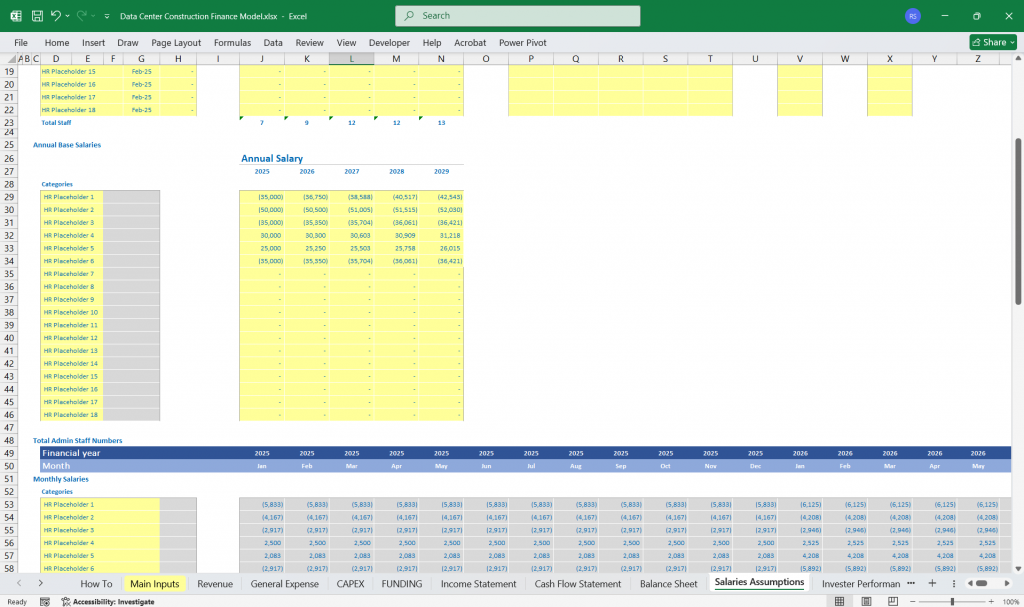
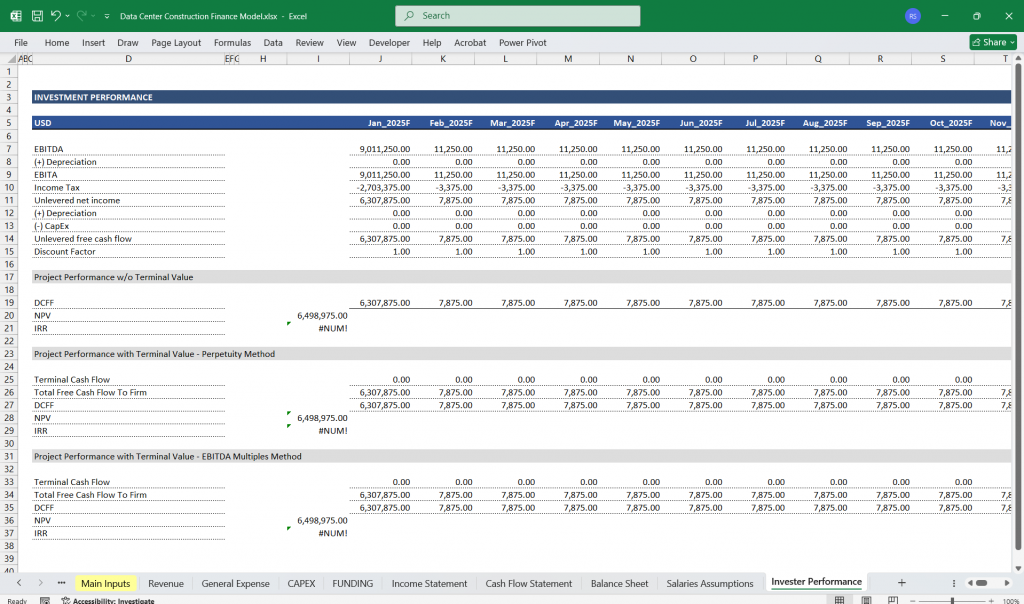
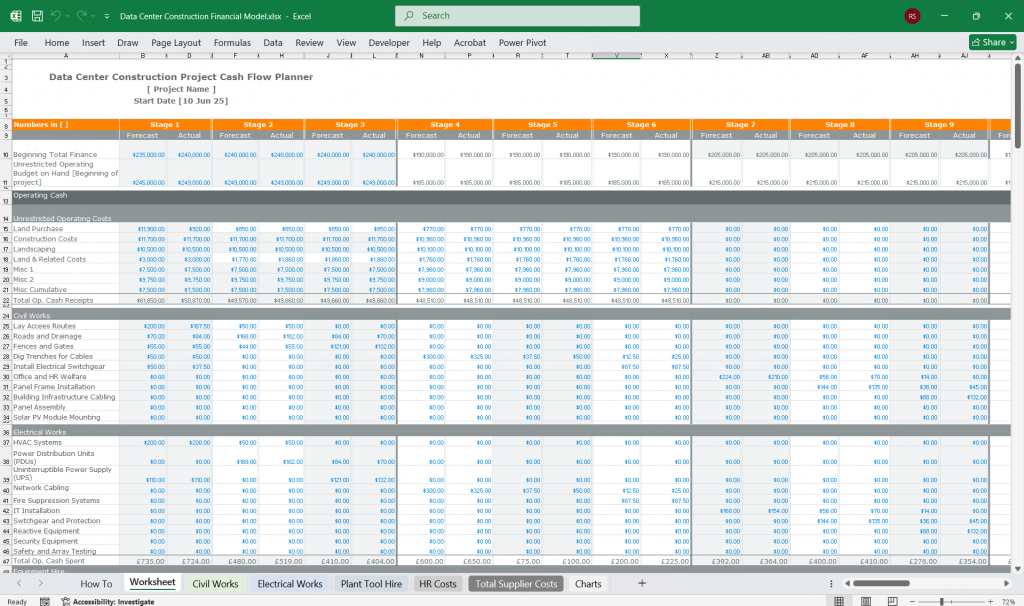
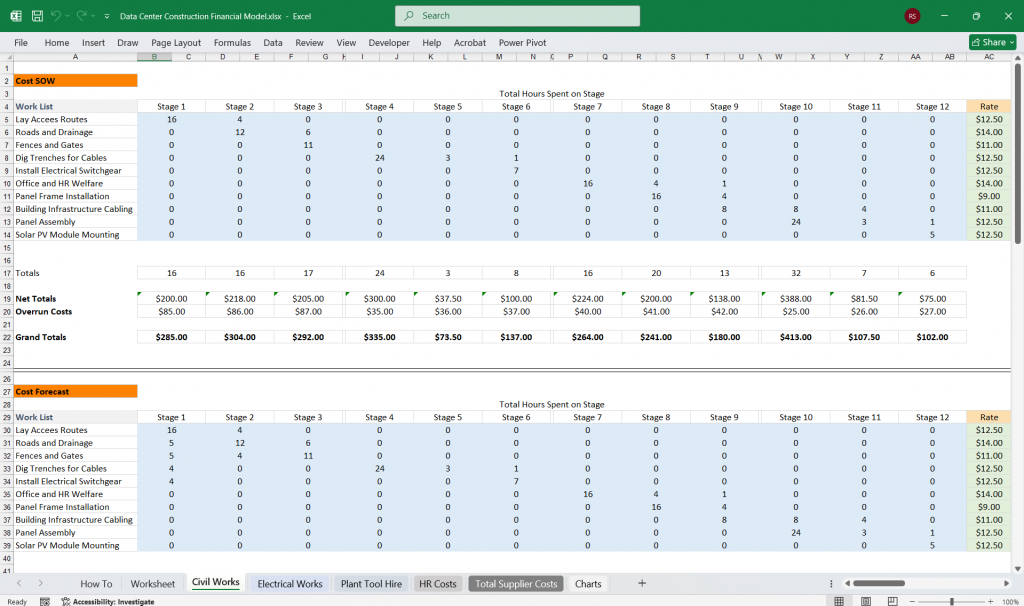
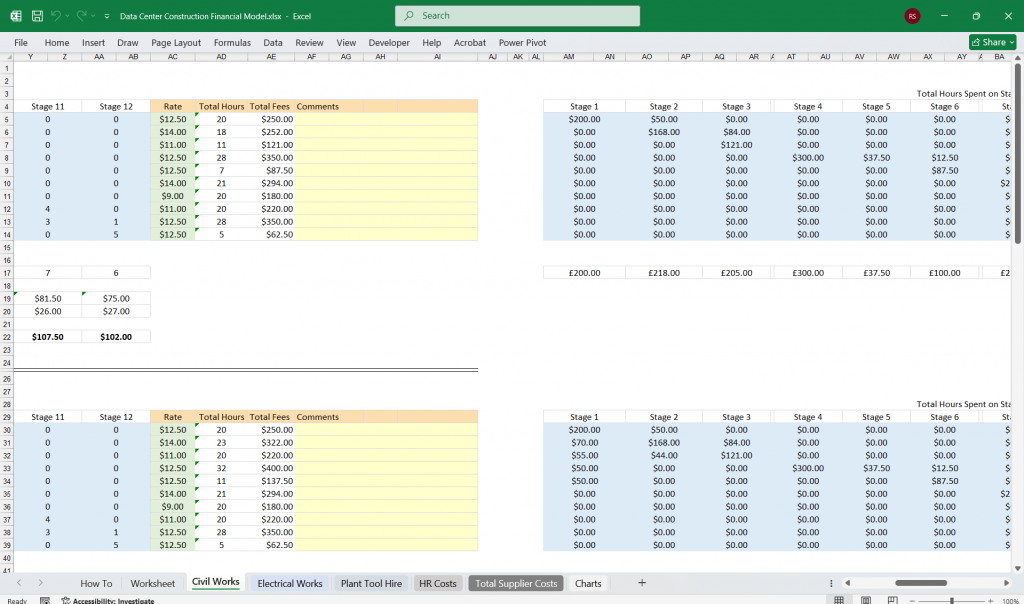
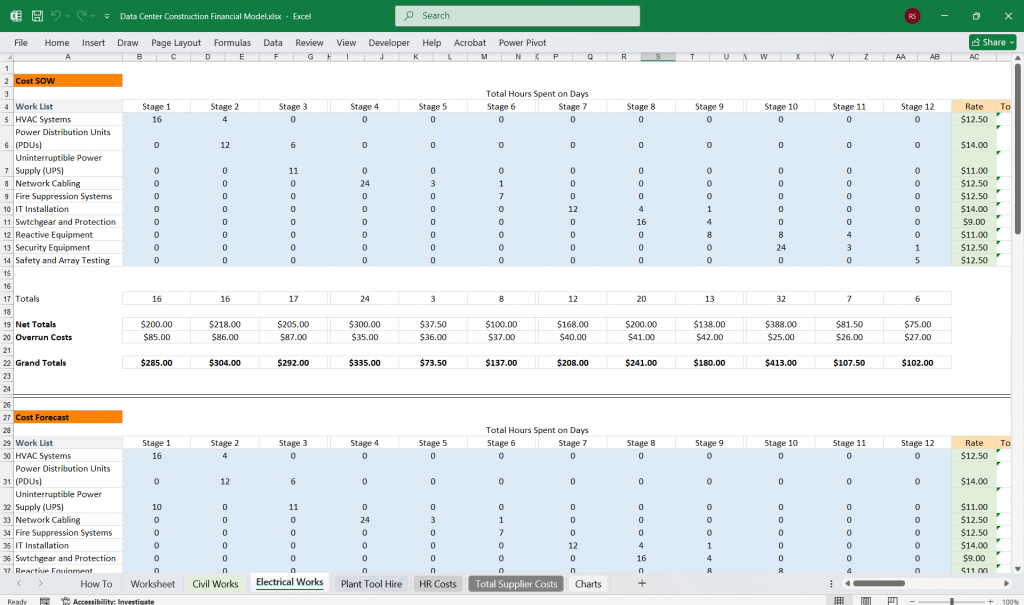
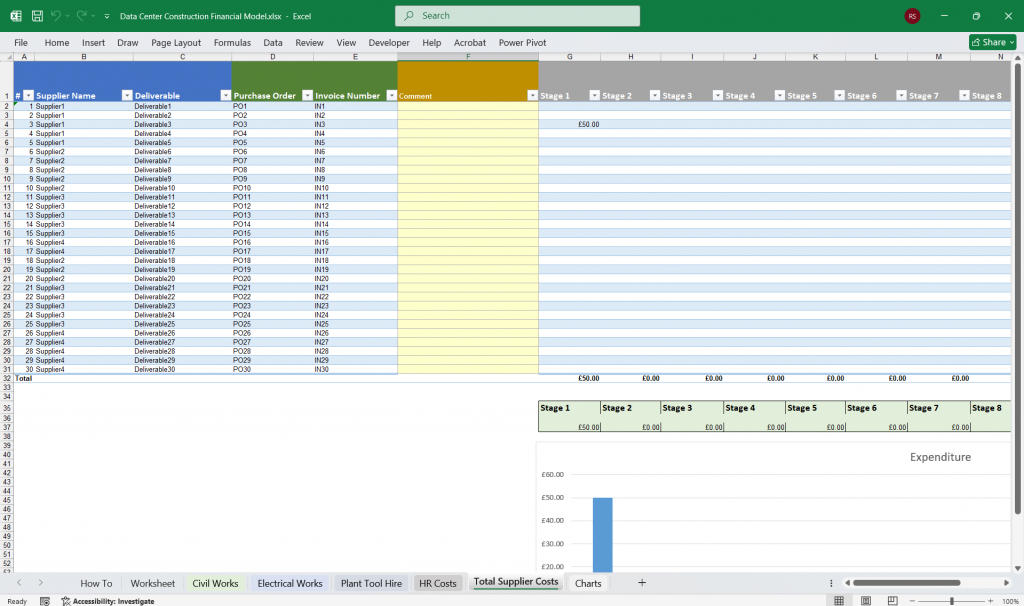
Key Financial Ratios
- Gross Profit Margin = (Gross Profit / Revenue) × 100%
- Operating Profit Margin = (Operating Profit / Revenue) × 100%
- Net Profit Margin = (Net Profit After Tax / Revenue) × 100%
- Return on Assets (ROA) = (Net Profit After Tax / Total Assets) × 100%
- Return on Equity (ROE) = (Net Profit After Tax / Equity) × 100%
- Current Ratio = Current Assets / Current Liabilities
- Debt-to-Equity Ratio = Total Debt / Total Equity
Conclusion
This financial model provides a detailed framework for assessing the viability of a data center construction project. It captures revenue sources from various construction and installation services, and operating expenses, and presents a structured income statement, cash flow statement, and balance sheet.
Download Available Immediately After Payment (You get 2 Models in 1 zip file)
